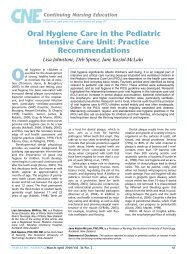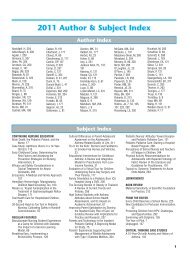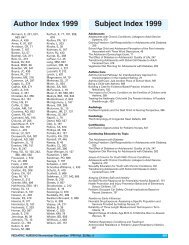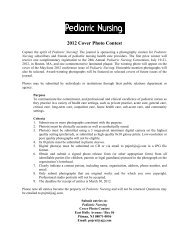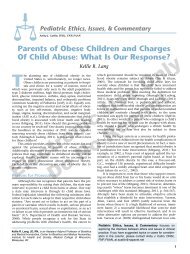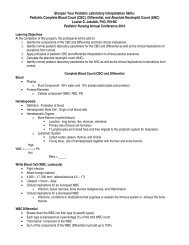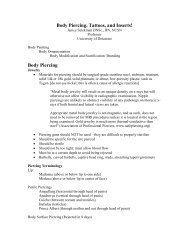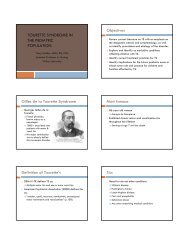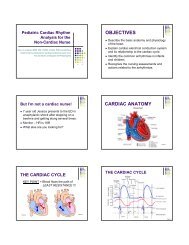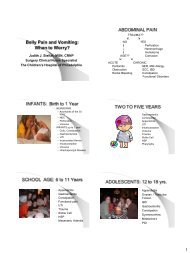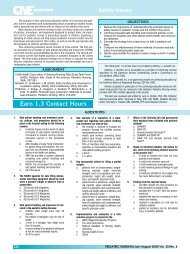Jannetti Publications Guidelines For Authors - Pediatric Nursing
Jannetti Publications Guidelines For Authors - Pediatric Nursing
Jannetti Publications Guidelines For Authors - Pediatric Nursing
You also want an ePaper? Increase the reach of your titles
YUMPU automatically turns print PDFs into web optimized ePapers that Google loves.
scripts can depend on one or more of these<br />
organizational patterns:<br />
a. Chronologic. Events or processes in the<br />
order in which they happened.<br />
b. Spatial. Physical relationships among<br />
persons, places, or things (east to west,<br />
small to big, up to down, inside to outside).<br />
c. Criteria. The measure or standard with<br />
which you are considering something<br />
(sales volume, typing errors per page,<br />
runs batted in).<br />
d. Importance. Either present the least<br />
important ideas first and build to the<br />
most important or vice versa.<br />
e. Familiarity. Go from the simple, easy-tounderstand,<br />
and familiar, to the more<br />
complex, hard-to-understand, and unfamiliar.<br />
f. Logical.<br />
(1) Use details, examples, illustrations.<br />
(2) Compare and contrast ideas.<br />
(3) Repeat and restate ideas.<br />
(4) Define terms.<br />
(5) Explain causes and effects, problems,<br />
and solutions.<br />
(6) Eliminate the alternatives (show<br />
what won’t work, and why).<br />
10. Review, cut, review, cut. The most important<br />
action you can take to improve your writing<br />
is to review what you’ve written and see<br />
where you can make it shorter and clearer.<br />
The more you can cut without forsaking<br />
meaning, the better. In writing, surgery is<br />
almost always justified. The most common<br />
fault of writing is wordiness. Here are some<br />
ways to cut words:<br />
a. Hunt every which. Make every which<br />
clause into another sentence.<br />
b. Kill every be. Get rid of the passive voice<br />
and replace any be verb with a strong,<br />
active, descriptive verb.<br />
c. Stick to your theme. Don’t get off the topic.<br />
Every sentence of every paragraph<br />
should be there only because it explains<br />
your central idea.<br />
d. Weed out ruthlessly. Take out any unnecessary<br />
words, sentences, phrases, and<br />
clauses that get in the reader’s way. Get<br />
rid of unnecessary articles like a, an, the,<br />
and conjunctions like as, and, while, and<br />
because. Often you can replace them with<br />
a semicolon. Sometimes you can leave<br />
out that. Read the sentence aloud and let<br />
the sound of the sentence tell you what<br />
you can omit.<br />
e. Challenge adjectives. Ask yourself if you<br />
really need all the adjectives. If you can<br />
substitute a more exact noun or, better<br />
yet, a strong verb, do it.<br />
f. Undangle the participles. A participle at the<br />
beginning of a sentence must have a<br />
noun to lean on (Bad: “Walking through<br />
the office, the typewriters are loud.”)<br />
B. Verb Checklist<br />
Circle every verb in your manuscript; then do the following<br />
things in the order listed:<br />
1. Cut out unnecessary verbs.<br />
a. Decide which are the main and secondary<br />
verbs in each sentence.<br />
b. Watch for main verbs disguised as secondary<br />
verbs.<br />
c. Look especially for verbs preceded by<br />
one of the following words: that, who,<br />
which, it (followed by is, are, or were).<br />
d. Eliminate as many secondary verbs as<br />
possible; make appositives, adjectives,<br />
prepositions. Example: “Ms. Jones, who<br />
was teaching us physics…” Change to:<br />
“Ms. Jones, our physics teacher…”<br />
2. Avoid the passive voice. Try to keep 70% of your<br />
verbs in the active voice. <strong>For</strong> example:<br />
a. Passive: Telephone triage was performed.<br />
b. Active: Nurses performed telephone<br />
triage.<br />
3. Avoid linking verbs.<br />
a. Look for all forms of the verbs to be and<br />
to have, and for verbs such as seem, look,<br />
and get.<br />
b. Permit no more than 30% of your verbs<br />
to be linking verbs.<br />
4. Eliminate needless adverbs.<br />
a. Look for words ending in -ly that appear<br />
close to verbs.<br />
b. Check for adverbs that are superfluous<br />
and remove them.<br />
10



